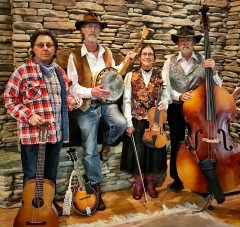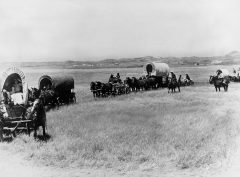Yesterday And Today
Westward Ho! Will John Henry Talk to the iGeneration?
How do four folk musicians keep a hundred kids’ attention for 40 minutes? With today’s youngsters, born and raised on flashy multimedia, the answer is not obvious. This was our first concern in developing a traditional music program for the classroom, but in the course of the project we learned that the secret ingredient may be poo.
May 2017. Elementary school principal asks Rocky: “Can you put together a program of folk songs for school assemblies?” Rocky: “Why not?”
We are Gemini Junction, an acoustic quartet with our genesis ten years ago, existing in our present form for about a year. Rocky is our most recent member, joining on upright bass after a fortuitous meeting during a Woody Guthrie celebration at the sadly missed Brick 15. He brought the idea to the group, and we immediately agreed. We’ve all been listening to American folk music for decades, we’ve all raised kids, and we see it as an honor and duty to share with the next generation. Plus, kids tend to be enthusiastic–our biggest fans after drunks.
My earliest musical memories are my dad singing songs he learned in Texas. Songs about cowboys and anything by guys named Hank or Merle. The past few years, I’ve been volunteering through Resounding Joy, playing old songs on my banjo for old people. I find the simple folk songs they learned as kids resonate with them better than anything else.
Annie Rettic and I met in 2007, shortly after she moved out from Michigan. Our music overlap was bluegrass, which has formed the foundation of our musical relationship through a half dozen band configurations and almost as many albums. Though she has classical musical training in voice and viola, with studies in Europe and Chicago, she is able to put all that aside to sing and play hillbilly harmonies and fiddle parts.
Richie Strell, our harmonica ace and spoon player, was raised in a progressive Jewish New York City household during the heyday of the 1950-’60s folk revival. The Weavers on the home record player; Pete Seeger playing on the Circle Line ferry boat; sneaking into Carnegie Hall for Joan Baez, Bob Dylan, and Peter, Paul and Mary; Richie has some stories!
Rocky started his music career in a high school duo playing the folk hits of the day from the Kingston Trio and Chad Mitchell. He worked under the classic philosophy of play guitar-get girls, which he claims worked fabulously. Rocky has spent most of the intervening years in jazz circles, but never forgot those three bedrock folk chords.
With all that folk music in our veins, we figured we could put together a dynamite program and have fun doing it. The biggest challenge was what songs to leave out. As you’ll see, our enthusiasm caused us to gloss over some issues we would have been wise to consider early on.
June 2017. Collect a song list, concentrating on Civil War to the 1890s.
We knew that we weren’t going to perform the program before summer holidays, so we didn’t feel rushed. We started with songs from my nursing home repertoire and found them mostly in the later 1800s, so we chose to focus on that era. A good reference was a book from my childhood, Songs We Sang.
We wanted a little talk between the songs to provide historical context and to introduce our instruments, all of which existed in pretty much their current form in the 19th century. We did not want to perpetuate the Manifest Destiny ideology that White Men were ordained to conquer and subjugate North America, though the songs on our list generally arose from that mindset.
First we needed to recognize the indigenous peoples. We quickly decided on a story rather than a song, and found a Comanche tale featuring the trickster Coyote. As we worked on the program, we realized our list did not acknowledge the African-American population freed after the Civil War, or any women at all. We sat on that for a while during summer hiatus.
September 2017. Finalize song list, assign speaking topics, draft our spoken material.
As we trickled back into town after our summer vacations, we wanted to nail down the program and prepare for performance. We added John Henry (a steel driving man!) to address the African-American contributions. We scratched several songs to fit our 40 minute target performance. We looked for a song that would celebrate women’s contributions. I read The Atlas of Western Expansion, which put the era into better perspective for me. That volume led me to the conclusion that women were largely precluded from history-making occupations in that era. (The “sporting trade” of the Wild West boom towns was out of bounds for this audience. Women’s suffrage, which was surprisingly active in the 1800s, may make a future iteration of the program.)
We settled on the song list you see in the sidebar, allocated songs among our three singers, and assigned spoken interludes to our four narrators. Rocky covers the Civil War and outlaws; I got wagon trains and banjos; Annie discusses the fiddle and Native Americans; Richie talks about railroads and the harmonica. (Abe Lincoln carried a harp … but could he sing the blues?)
October 2017. Refine the material, first dry run.
Once we got the program written and collated, we ran through it every rehearsal. The songs came together easily. The narration took some work to get smooth, consistent and snappy. We were still concerned about keeping the kids’ attention and we had nightmares of the concert devolving into a preteen mosh pit. We’re pretty good at engaging children in small groups, but the idea of an auditorium packed with i-kids can be daunting.
So, we looked to people with experience. A long-time youth soccer coach and a couple of retired schoolmarms suggested: get them singing and clapping. So we started to work audience participation features into each song.
The key tip was offered by my son Evan, who worked an after-school program for San Francisco fourth graders. He divulged a surefire way to engage that demographic. It was confirmed by the schoolmarms, though they warned us it is a powerful tool not to be taken lightly or overused. The secret: every fourth grader finds the concept of poop to be endlessly fascinating and hilarious. A single poo joke will keep them giggling for several minutes.
So, we were challenged to slip in some poop references for the kids, without offending the administrators. We may have to fine tune this delicate balance as we go along. Currently we note the need for good wagon train boots while walking twelve miles a day amongst all the oxen and their droppings. I suspect we can do better.
November 2017. Dialog with the school.
The holiday season was peeking over the horizon and it was time to close the loop with the principal. We figured we’d do a dry run for her, incorporate any feedback (how about that poop joke?), and finalize the program. Turned out she trusted Rocky to deliver the goods, and put us in touch with her staff for scheduling.
Our first “should have thought about that before” issue arose in relation to the California social studies curriculum. We figured we might have to justify our inclusion of official subject matter to get funding. Grade 3 covers local community, grade 4 covers California, grade 5 covers up to the Civil War, and grade 6 covers world history. Oops! OK, so we expanded our scope to encompass the 5th grade curriculum.
Then we faced our second issue: how much to charge for the program? None of us had experience in this market, and some quick research did not provide good guidance. The school was thinking “one hour of work,” but after I explained all our years of experience, all our equipment, and all our preparation, we agreed on a fair stipend. Funding comes from the PTA, so we’re grateful the school community is willing to invest in these programs.
December 2017. Schedule the assembly.
We agreed on a spring date, with paperwork and details to be worked out later. In the meantime, we were busy keeping our primary band repertoire alive, bringing in some new material, and gigging.
At the time of this writing, we’ve got a solid kids program poised for takeoff. We’ve got a friendly location and a March date for its first performance and have started dialog with other schools. We’ve sent lyrics to the school so the kids can prepare for singalong. We did a quick photo shoot with an 1800s vibe and have ideas for a video and are working on promo materials. With all that in place, we’re ready to take this show on the road, planting American folk music seeds for the youngest generation. In preparation, we take strength from the spirit of the old west, embodied in words of General George Custer, “Let’s kick their ass and get the Hell out of here.”
P.S. If you know any good poop jokes, please send them to jt@moring.net.
THE PROGRAM
“Oh! Susanna” (Foster, 1847). This was the first mega hit in American music and holds special meaning for Richie and me, as it was our first song learned on harmonica and banjo, respectively. We figured every kid should know it if they don’t already.
“Home on the Range” (Higley/Kelley, 1871). This fits the theme well and is a familiar song that the kids should be able to sing.
“When Johnny Comes Marching Home” (Gilmore/Lambert, 1863). We wanted to include a reference to the Civil War, and this has the great “Harrah! Hurrah!” line and not too much militarism.
“Wagon Master” (Moring, 2009). This song tells the story of my great granddad who caught a wagon train from Tennessee to Texas after the Civil War. Hopefully it will help the kids realize that we’re all part of history and that family stories can be interesting.
“Coyote and the Buffalo” (Comanche story). We quickly gave up on performing authentic Native American music and decided that a short story from the rich native heritage would provide a nice change of pace.
“Workin’ on the Railroad” (ca. 1896). With its several parts, this is just a fun song, and introduces the intercontinental railroad.
“John Henry” (ca. 1890). Another railroad song, which we use to introduce contributions of African-Americans, including the banjo.
“Glendale Train” (Dawson, 1971). This New Riders of the Purple Sage tune about a fictional train robbery is a regular in our repertoire, and we just love the three-part harmonies. Plus, there are outlaws! So, there!
“This Land is Your Land” (Guthrie, 1940). Though not from the historical period, the song is timeless, and we figured it’s another one the kids should know. Migration was not limited to the 19th or 20th centuries, although today’s migrants may be coming from Somalia rather than Tennessee or Oklahoma. (We’re debating whether to include the “one side said ‘No Trespassing,’ the other side didn’t say nothing” verse.)
Â








